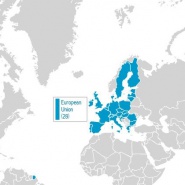Climate Plans and the Role of Land Use: A Running Tab
As countries submit their plans to cut greenhouse gas emissions – commitments known as Intended Nationally Determined Contributions, or INDCs – ahead of this year’s international climate negotiations, the role of forests and land use in this agreement is still developing. This article will be updated often to offer summaries of how land use is included (or not) in INDCs as they are submitted to the United Nations Framework Convention on Climate Change (UNFCCC).

As countries submit their plans to cut greenhouse gas emissions – commitments known as Intended Nationally Determined Contributions, or INDCs – ahead of this year’s international climate negotiations, the role of forests and land use in this agreement is still developing. This article will be updated often to offer summaries of how land use is included (or not) in INDCs as they are submitted to the United Nations Framework Convention on Climate Change (UNFCCC).
If you want to read the INDC documents, they are all available here.
GABON*
INDC submitted: April 1, 2015
Notable because: It’s the first African country to submit an INDC.
The basics: Gabon will cut emissions by at least 50% by 2025 compared to a business-as-usual scenario.
Inclusion of land use: Gabon notes that 88% of its land area is covered by forests and the country therefore acts as a net carbon sink, absorbing four times the carbon dioxide it emits. Since 2000, Gabon has adopted a Forest Code, created 13 national parks that ban logging across large areas, and created a National Land Use Plan that identifies carbon-rich forests. However, the country notes that it does not want to rely on international carbon finance to preserve its forests, stating that these market mechanisms hinder its sovereign economic development.
*This INDC was submitted in French and has been roughly translated.
RUSSIA*
INDC submitted: March 31, 2015
Notable because: Russia’s submission means that two-thirds of industrialized nations covering 80% of emissions from developed countries have now released their climate plans.
The basics: Russia will limit emissions to 70-75% of 1990 levels by 2030, on one condition…
Inclusion of land use: Russia’s commitment is conditional on the “maximum consideration” of forests in emissions accounting under the UNFCCC. The country notes that it houses 70% of the world’s boreal forests and 25% of the world’s forests overall. Protecting these forests is the “most important element” of Russia’s climate policy, the INDC states.
*This INDC was submitted in Russian and has been roughly translated.
UNITED STATES
INDC submitted: March 31, 2015
Notable because: The United States is the second largest emitter in the world.
The basics: The U.S. will reduce emissions 26-28% below 2005 levels by 2025.
Inclusion of land use: The U.S. does not intend to use international carbon market mechanisms to meet its targets – a move that would appear to exclude mechanisms such as Reducing Emissions from Deforestation and forest Degradation (REDD+). However, it will account for emissions from the land sector using a “net-net” approach, which in UNFCCC-speak means subtracting the net emissions in the accounting period from the net emissions in 1990, the base year for most countries. This land-use carbon accounting will include emissions by sources and removals by sinks as reported in the Inventory of United States Greenhouse Gas Emissions and Sinks, including everything from cropland to forest land to wetlands to rice cultivation.
NORWAY
INDC submitted: March 27, 2015
Notable because: Norway has been an early and consistent supporter of international efforts to reduce deforestation through payments for performance to REDD projects. Its International Climate and Forest Initiative has funding up to three billion Norwegian Krones ($517 USD) per year pledged to avoided deforestation efforts, from the Brazilian Amazon Fund to the Congo Basin Forest Fund.
The basics: Norway will cut emissions at least 40% by 2030 compared to 1990 levels.
Inclusion of land use: Accounting emissions from the land-use sector remains a question mark for Norway. “Net removals” of greenhouse gases by forests accounted for 10.1 million tonnes of carbon dioxide equivalent (MtCO2e) in 1990 – about a fifth of Norway’s total emissions in that year. As forests grow, Norway projects that the land-use sector will account for 21.2 MtCO2e in net removals by 2030. The country does not currently have a final position on land-use carbon accounting, but plans to work with European Union member states to come up with one. Depending on the outcome, “the commitment would need to be recalculated to ensure that the ambition level stays unchanged,” according to the INDC.
MEXICO
INDC submitted: March 30, 2015
Notable because: Mexico was the first developing country to submit an INDC.
The basics: Mexico will unconditionally reduce its emissions 25% under the business-as-usual scenario by 2030. With access to financial resources and technology under an international agreement, the country has set a more ambitious “conditional” target of a 40% emissions cut.
Inclusion of land use: Mexico’s INDC states that the country will reach zero deforestation by 2030 and focus reforestation efforts in riparian zones, to promote ecosystem-based adaptation in important watersheds.
EUROPEAN UNION
INDC submitted: March 6, 2015
Notable because: It covers 28 Member States and sets the tone for an entire region.
The basics: The European Union and its Member States will reduce domestic emissions at least 40% by 2030 compared to 1990 levels.
Inclusion of land use: The EU’s INDC states that “Policy on how to include Land Use, Land Use Change and Forestry into the 2030 greenhouse gas mitigation framework will be established as soon as technical conditions allow and in any case before 2030.” A previous EU decision sets rules for how to account for carbon emissions from the land use sector, but is just a first step.
Please see our Reprint Guidelines for details on republishing our articles.

